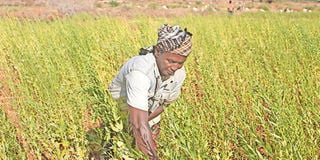Simsim, the wonder crop minting money in dry North

Maalim Dakane harvests simsim at the Aresa Irrigation Scheme in Mandera County. Simsim is an excellent source of calcium, iron, phosphorus and dietary fibre. PHOTO | ANGELA OKETCH | NMG
What you need to know:
- At least 21 farmers grow the crop at the scheme, at least twice a year as they also rotate with others.
- Planting simsim is not labour intensive as the crop is easy to manage and needs little water throughout the year.
- Researchers have further found out that simsim cultivation reduces nematode populations in the soil.
- The plant takes three months to mature. It can be planted either on seedbed before it is transplanted or through broadcasting.
Aresa Irrigation Scheme in Mandera County relies on water from seasonal River Daua that flows from the neighbouring Ethiopia.
The scheme has become the centre of agricultural activities in the semi-desert region, with some farmers growing maize, watermelons, oranges, pawpaws, lemons, guavas and simsim.
However, simsim (sesame indicum) stands out and it has become the wonder crop of the region as it puts money in farmers’ pockets.
Maalim Dakane is one of the farmers growing simsim at Aresa, having started with maize before making the switch.
“I planted maize on an acre and all I harvested were two 90kg bags, which discouraged me,” he says, recounting the experience that happened three years ago.
A farmer friend at the scheme then introduced him to simsim, taking him through the process of growing and managing it. He then bought seeds from him.
“When I started growing simsim, I only had faith. I planted on quarter acre of my farm and got good yields. This motivated me to plant the whole farm,” Dakane tells Seeds of Gold during a tour of his farm at the 206-acre irrigation scheme that is managed by the county government.
At least 21 farmers grow the crop at the scheme, at least twice a year as they also rotate with others.
Early this year, Dakane harvested 10 bags of simsim, which he sold for at least Sh6,000 each to the county government, which buys and later sells to a processor making oil from the produce.
Planting simsim is not labour intensive as the crop is easy to manage and needs little water throughout the year. And Dakane says he does not use any fertiliser or pesticides on the crop.
Mohamed Osman Salat, an extension officer in Mandera, notes simsim is a survivor plant that is drought-resistant, thus, it grows well in dry areas like Mandera.
“Simsim is also a highly drought and heat tolerant crop and can provide good harvest when soil moisture is adequate. It also has excellent disease and insect tolerance. It’s not a must that it’s grown using fertiliser though a farmer can use it to boost the fertility of soil,” he offers.
Researchers have further found out that simsim cultivation reduces nematode populations in the soil.
This potential pest resistance property is a further boost in lowering production costs, and an attraction for farmers in low-income areas.
The plant takes three months to mature. It can be planted either on seedbed before it is transplanted or through broadcasting. If planted in rows, a spacing of 30x10cm should be considered.
HEALTH BENEFITS
The seeds are placed at a depth of 3cm because of their smaller size and covered with soil. The distance between the plants should be 10cm.
“Simsim grows very fast and the first weeding should be done at two weeks after germination since it is very sensitive to weed competition in early growing stages,” says Salat, adding the most common varieties in East Africa are Serra and Sesi-1.
The crop is ready when the stem changes from green to yellow and then to red and the leaves begin to fall off.
Harvesting should be done when 75 percent of the fruit capsules have ripened.

The farmers gather their simsim harvest. Cultivating the crop is not labour intensive as it is easy to manage and needs little water throughout the year. PHOTO | ANGELA OKETCH | NMG
“One harvests either by uprooting the whole plant or cutting stems using a knife. The stems are then tied into bundles, stalked upright, and placed in sacks. One week after harvesting, thrash and winnow the seeds, which should be stored with 10 percent moisture content,” says Salat, noting the simsim grows in limited resources but offers more returns.
Dakane normally delivers his produce in Mandera town to the county government for oil extraction. The waste is then fed to livestock to enrich milk production.
Some 150kg of simsim produces 20 litres of oil, with a litre going for Sh400.
“Simsim also acts as an appetiser when it is heated together with sugar and eaten. It is also mixed with other crops that include sorghum to make nutritious porridge flour for babies,” says Salat, noting the produce is much loved among the Muslim community.
He adds that simsim is an excellent source of calcium, iron, phosphorus and dietary fibre.
It also contains sesamin and sesamolin that have a cholesterol-lowering effect in humans, and helps prevent high blood pressure and increase Vitamin E supply in animals.
It has also been found to protect the liver from oxidative damage.
Mandera County director of agriculture Bernard Ogutu says there is huge potential for crop production through irrigation along the banks of River Daua, which flows for nine months in a year.
“We are encouraging farming as a business for locals to stop overreliance on relief food,” Ogutu says, adding that sweet watermelons are now grown in large-scale along the river and sold to markets as far as Nairobi.
Simsim farming is “picking up well” in Mandera and that the produce is mostly sold in Nairobi and Ethiopia.
Mandera is currently a net importer of food. It is an arid region but has rich unexploited soils.





